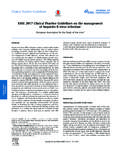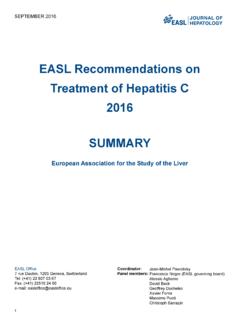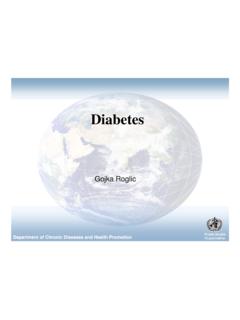Transcription of The Burden of liver disease in europe
1 The Burden of liver disease in europeMartin Blachier, Henri Leleu, Markus Peck-Radosavljevic, Dominique-Charles Valla and Fran oise Roudot-Thoraval2013A review of AvAilAble epidemiologicAl dAtA2eUropeAN assOCiaTiON for tHe sTUdY OF THe liver easltAble of coNteNtsfigUrestAblesoverview iNtrodUctioNmetHodsresUltscirrHosisprimA ry liver cANcerliver trANsplANtAtioNAlcoHol ANd liver diseAseHepAtitis AHepAtitis bHepAtitis cHepAtitis dHepAtitis eNoN-AlcoHolic fAtty liver disease (NAfld)drUg iNdUced liver iNjUries (dili)HAemocHromAtosisAUtoimmUNe HepAtitisprimAry biliAry cirrHosis (pbc)primAry sclerosiNg cHolANgitis (psc)coNclUsioNrefereNces234567812161922 252830313236374041424348tAble of CONTeNTsTHe Burden OF liver disease iN europe A review of AvAilAble epidemiologicAl dAtA3fig. 1 liver cirrhosis mortality in mediterranean countries and in Hungary, males 20-64 years, 2 Age-standardized death rates per 100,000 population from liver cirrhosis in european countries, males and females aged 20 64; wHo mortality database 3 estimated age-standardized incidence rates of liver cancer per 100,000 in 2008; wHo, globocAN, 4 estimated age-standardized mortality rates per 100,000 for liver cancer in 2008; wHo, globocAN, 5 Number of liver transplantations in european countries, may 1968 to december 2009; 6 growth in the annual numbers of liver transplants in 7 primary liver diseases leading to liver transplantation in europe , january 1988 to december 8 primary indications for liver transplantation in europe among patients with cirrhosis, january 1988 to december 9 mortality from alcohol-related liver diseases among men in european countries in 2005.
2 WHo 10 mortality from alcohol-related liver diseases among women in european countries in 2005, wHo 11 Alcohol consumption in europe in 2005; wHo. fig. 12 Alcohol consumption in europe between 1990 and 2006; wHo 13 Hospitalisation for hepatitis A, incidence per 100,000 inhabitants in europe ; 14 incidence rates of hepatitis b in eU27 countries in 2005; ecdc 15 primary indications for liver transplantation in europe among patients with virus-related liver disease (january 1988 to december 2009).fig. 16 obesity rates among populations of european countries; oecd Health data assOCiaTiON for tHe sTUdY OF THe liver easl4table 1 european studies assessing the prevalence or incidence of liver 2 european studies assessing incidence of primary liver 3 incidence rates of HAv infection in 4 prevalence rates of HAv infection in 5 Age-specific Hbv seroprevalence in european 6 Hbv incidence in 7 seroprevalence of chronically Hbv-infected patients in 8 Hcv prevalence in 9 european studies assessing the prevalence of 10 european studies assessing the prevalence and incidence of autoimmune 11 incidence of liver diseases per 100,000 inhabitants per year in europe (where data is available).
3 Table 12 prevalence (%) of liver diseases in europe (where data is available).table 13 inter-country comparison of the number of deaths associated with selected diseases compared to liver diseases based on death certificates (age-standardized); wHo, 14 inter-country comparison of the prevalence of Hbv, Hcv and 17 Hospital admissions attributed to haemochromatosis in england from 1989/1990 to 2002/2003. (a) Age-standardized in-patient admission rate per 100,000 per year. (b) Age-standardized day-case admission rate per 100,000 per 18 primary indications for liver transplantation in europe among patients with cholestatic diseases, january 1988 to december Burden OF liver disease iN europe A review of AvAilAble epidemiologicAl dAtA5 Overviewthe past 30 years have witnessed major progress in the knowledge and management of liver disease , yet approximately 29 million people in the european Union still suffer from a chronic liver condition.
4 Difficulties in accessing data from individual countries hinder global evaluation of liver disease in europe . this report reviews 260 epidemiological studies published in the last five years to survey the current state of evidence on the Burden of liver disease in europe and its causes. the incidence and prevalence of two conditions, cirrhosis and primary liver cancer, are key to understanding the Burden of liver disease . they represent the end-stage of liver pathology and thus are indicative of the associated mortality. literature on the prevalence and incidence of cirrhosis is scarce. However, available data suggest that about of the european population is affected by cirrhosis, corresponding to 14-26 new cases per 100,000 inhabitants per year or an estimated 170,000 deaths per year [2]. there are, however, large intra-european variations. About of Hungarian males will die of cirrhosis every year compared with of greek females.
5 Hepatocellular carcinoma (constituting 70-90% of cases of primary liver cancer) is the fifth most common cause of cancer in europe and one of the most serious outcomes of cirrhosis. european epidemiological data show that there are 1-13 new cases of hepatocellular carcinoma and 1-10 deaths per 100,000 inhabitants per year. wHo estimate that liver cancer is responsible for around 47,000 deaths per year in the four leading causes of cirrhosis and primary liver cancer in europe are harmful alcohol consumption, viral hepatitis b and c and metabolic syndromes related to overweight and obesity. chronic alcohol consumption is the main cause of cirrhosis in europe . Alcohol consumption decreased in the 1990s, but has increased again in the last decade to stabilize at a high level of >9 litres of pure alcohol per year on average, although there are large variations among european countries. chronic viral hepatitis b is the second major cause of both cirrhosis and liver cancer.
6 Between and of the european population is affected by chronic hepatitis b, with the highest prevalence being recorded in romania ( ) and greece ( ). by comparison, Hiv prevalence is only (Hiv is 50-100 times less infectious). the availability of a vaccine has resulted in a decrease in the prevalence of Hbv, although it remains responsible for 30% of cases of cirrhosis and 15% of cases of primary liver cancer. chronic hepatitis c is an important risk factor for hepatocellular carcinoma, which develops several decades after infection. since the discovery of the virus in the late eighties, the number of new cases of infection has dropped substantially. prevalence rates of hepatitis c virus (Hcv) infection in the last decade in the european population were between and , the highest rates being found in italy and romania. these Hcv-infected populations will develop complications in the years to come, leading to a substantial increase in the Burden of disease .
7 It is of great concern that about 90% of people in europe infected by viral hepatitis are unaware of their fatty liver disease (NAfld) is becoming a major concern with the increasing incidence of obesity in europe . in this condition, accumulation of fat in the liver leads to chronic liver disease . Available data suggest the prevalence rate of NAfld is 2 44% in the general european population (including obese children) and in people with type 2 diabetes. NAfld increases the risk of cirrhosis and liver of these four major causes of liver disease is amenable to prevention and treatment, reducing the Burden of liver disease in europe and saving lives. However, epidemiological data are scarce. Additional surveys are urgently needed to provide reliable information, without which it will not be possible to implement cost-effective prevention programmes and novel treatments to tackle liver disease and avoidable deaths in assOCiaTiON for tHe sTUdY OF THe liver easlthe past 30 years have witnessed major progress in the knowledge and management of liver disease yet approximately 29 million persons in the european Union still suffer from a chronic liver condition.
8 Difficulties in accessing data from individual countries hinder comprehensive evaluation of the Burden of liver disease in europe and comparison with other diseases. moreover, very few reviews have studied both chronic liver conditions, such as cirrhosis and cancer, and their major causes, such as viral hepatitis, alcohol intake and metabolic syndrome. it is likely that the causes of chronic liver diseases differ from country to country but no reliable data exist about this. A large systematic review of all epidemiological data available for european countries has hitherto not been undertaken. Here we review evidence of the Burden and causes of liver disease in europe , drawing on a survey of all epidemiological data published over the course of the last five Burden OF liver disease iN europe A review of AvAilAble epidemiologicAl dAtA7medliNe, embAse, and the cochrane library were searched for relevant articles using the following medical subject headings (mesH) terms liver and [ disease or epidemiology ].
9 The search encompassed articles published throughout the last five years in any european language. studies were included if: (1) they presented epidemiological data; (2) they included patients who lived in the european Union (eU27) or Norway (but not necessarily exclusively so); (3) they were published or accepted for publication as full-length articles. studies were excluded if: (1) they estimated prevalence or incidence from data collected before 1995; (2) they studied very specific populations; (3) they were published only in abstract form so that the methodological quality could not be assessed. when the results of a single study were reported in more than one publication, only the most recent and complete data were included in the systematic manual search of references cited in retrieved articles was also conducted to identify studies not found in the database search. data presented in world Health organization (wHo) reports, in european centre for disease prevention and control (ecdc) reports and on were also available data on liver disease incidence and prevalence and on associated mortality and trends were extracted from the reviewed articles.
10 Most mortality statistics were derived from official causes of death recorded on death certificates. of 4,256 reviewed studies, 260 met the inclusion european liver transplant registry (eltr) was used to describe the epidemiology of liver transplantation in europe as it represents more than 95% of all official published european data (fig. 5, page 16).geographical factors necessitate caution in the interpretation of parts of this review for two reasons: (1) inter-country variation in death-reporting processes; therefore caution must be exercised when making comparisons between countries; (2) the definition of the european zone varies according to the source, so care must be taken when assessing data reported at the european level. According to wHo, european countries include all eastern and central european countries as well as the russian federation. by contrast, data given for the eU27 refer only to countries that belong to the european Union.












